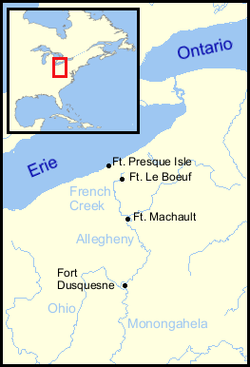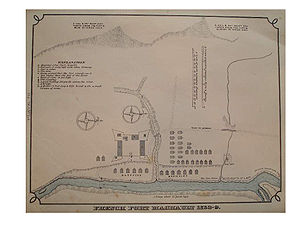
Fort Machault
Encyclopedia
Fort Machault was a fort built by the French
in 1754 near the confluence of French Creek
with the Allegheny River
, at present-day Franklin, in northwest Pennsylvania
. The fort was part of a line that included Fort Presque Isle
, Fort Le Boeuf
, and Fort Duquesne
.

s in the form of polygons. The bastions were built of saplings, eight inches (203 mm) thick, and 13 feet (4 m) in height. The gate fronted the river. Inside the fort were a magazine, several officer's barracks, with two stories and stone chimneys. The soldiers barracks consisted of 45 buildings outside the fort.
used the Venango Path
to reach Fort Machault during his first expedition into the Ohio Country. Washington, with an escort of seven men and a letter from Governor Robert Dinwiddie
of Virginia, protesting the French invasion of lands claimed by Great Britain and demanding their immediate withdrawal. The French officer at the fort said he did not have the power to negotiate with the British. Therefore, he told Washington to go to Fort Le Boeuf instead to meet with a higher ranking officer.
Captain Chabert de Joncaire finished building Fort Machault in April, 1754. The fort was named in honor of a prominent political and financier, Jean Baptiste de Machault D'Arnouville
.
The French and Indian War
began on May 28, 1754 with the Battle of Jumonville Glen
.
In 1756, William Johnson, who had escaped from Native Americans
, described the fort as a "Captain's command of about 50 men; the Fort of Stockades, very weak, and scarce of provisions . . . "
In 1758, Colonel Mercer, in a report from Fort Pitt
, reported that there were about 100 soldiers at Fort Machault, where the French had 11 flat-bottomed boats called "batteaus" and a large gun the size of a quart pot "which they fire off by a train of powder."
In July 1759, the French began a campaign to capture Fort Pitt
. Nearly a thousand French and Canadiens, and a thousand Native Americans mustered at Fort Machault. The British, however, began a siege of Fort Niagara
. The assault on Fort Pitt
was abandoned, and available forces were sent to relieve Fort Niagara.
On July 25, 1759, the French surrendered Fort Niagara
. In August 1759, the commander of Fort Presque Isle
sent word to Fort Le Boeuf
and Fort Machault to abandon their forts. The French burned Fort Machault to the ground.

French colonization of the Americas
The French colonization of the Americas began in the 16th century, and continued in the following centuries as France established a colonial empire in the Western Hemisphere. France founded colonies in much of eastern North America, on a number of Caribbean islands, and in South America...
in 1754 near the confluence of French Creek
French Creek (Allegheny River)
French Creek is a tributary of the Allegheny River in northwestern Pennsylvania and western New York in the United States.- Etymology :...
with the Allegheny River
Allegheny River
The Allegheny River is a principal tributary of the Ohio River; it is located in the Eastern United States. The Allegheny River joins with the Monongahela River to form the Ohio River at the "Point" of Point State Park in Downtown Pittsburgh, Pennsylvania...
, at present-day Franklin, in northwest Pennsylvania
Pennsylvania
The Commonwealth of Pennsylvania is a U.S. state that is located in the Northeastern and Mid-Atlantic regions of the United States. The state borders Delaware and Maryland to the south, West Virginia to the southwest, Ohio to the west, New York and Ontario, Canada, to the north, and New Jersey to...
. The fort was part of a line that included Fort Presque Isle
Fort Presque Isle
Fort Presque Isle was a fort built by French soldiers in 1753 along Presque Isle Bay at present-day Erie, Pennsylvania...
, Fort Le Boeuf
Fort Le Boeuf
Fort Le Boeuf, , was a fort established by the French in 1753 on a fork of French Creek, in present-day Waterford, in northwest Pennsylvania...
, and Fort Duquesne
Fort Duquesne
Fort Duquesne was a fort established by the French in 1754, at the junction of the Allegheny and Monongahela rivers in what is now downtown Pittsburgh in the state of Pennsylvania....
.

Description
The fort was built on a hill, 60 yards west of the Allegheny River. The fort was in the form of a parallelogram, about 75 by 105 feet (32 m). The curtain was made of hewed timber, stacked lengthwise. The four corners had bastionBastion
A bastion, or a bulwark, is a structure projecting outward from the main enclosure of a fortification, situated in both corners of a straight wall , facilitating active defence against assaulting troops...
s in the form of polygons. The bastions were built of saplings, eight inches (203 mm) thick, and 13 feet (4 m) in height. The gate fronted the river. Inside the fort were a magazine, several officer's barracks, with two stories and stone chimneys. The soldiers barracks consisted of 45 buildings outside the fort.
History of the Fort
In December of 1753, George WashingtonGeorge Washington
George Washington was the dominant military and political leader of the new United States of America from 1775 to 1799. He led the American victory over Great Britain in the American Revolutionary War as commander-in-chief of the Continental Army from 1775 to 1783, and presided over the writing of...
used the Venango Path
Venango Path
Venango Path was a Native American trail that ran from the Forks of the Ohio to Presque Isle, Pennsylvania, United States of America. The trail was named after the Native American village of Venango where French Creek empties into the Allegheny River...
to reach Fort Machault during his first expedition into the Ohio Country. Washington, with an escort of seven men and a letter from Governor Robert Dinwiddie
Robert Dinwiddie
Robert Dinwiddie was a British colonial administrator who served as lieutenant governor of colonial Virginia from 1751 to 1758, first under Governor Willem Anne van Keppel, 2nd Earl of Albemarle, and then, from July 1756 to January 1758, as deputy for John Campbell, 4th Earl of Loudoun...
of Virginia, protesting the French invasion of lands claimed by Great Britain and demanding their immediate withdrawal. The French officer at the fort said he did not have the power to negotiate with the British. Therefore, he told Washington to go to Fort Le Boeuf instead to meet with a higher ranking officer.
Captain Chabert de Joncaire finished building Fort Machault in April, 1754. The fort was named in honor of a prominent political and financier, Jean Baptiste de Machault D'Arnouville
Jean Baptiste de Machault D'Arnouville
Jean-Baptiste de Machault d'Arnouville, comte d'Arnouville, seigneur de Garge et de Gonesse, was born in Paris on December 13, 1701, and died on July 12, 1794 in a French Revolutionary prison...
.
The French and Indian War
French and Indian War
The French and Indian War is the common American name for the war between Great Britain and France in North America from 1754 to 1763. In 1756, the war erupted into the world-wide conflict known as the Seven Years' War and thus came to be regarded as the North American theater of that war...
began on May 28, 1754 with the Battle of Jumonville Glen
Battle of Jumonville Glen
The Battle of Jumonville Glen, also known as the Jumonville affair, was the opening battle of the French and Indian War fought on May 28, 1754 near what is present-day Uniontown in Fayette County, Pennsylvania...
.
In 1756, William Johnson, who had escaped from Native Americans
Native Americans in the United States
Native Americans in the United States are the indigenous peoples in North America within the boundaries of the present-day continental United States, parts of Alaska, and the island state of Hawaii. They are composed of numerous, distinct tribes, states, and ethnic groups, many of which survive as...
, described the fort as a "Captain's command of about 50 men; the Fort of Stockades, very weak, and scarce of provisions . . . "
In 1758, Colonel Mercer, in a report from Fort Pitt
Fort Pitt
Fort Pitt may refer to:*Fort Pitt , on the site of present-day Pittsburgh, Pennsylvania, in the United States*Fort Pitt, Kent, in the United Kingdom*Fort Pitt , a trading post of the Hudson's Bay Company in Canada...
, reported that there were about 100 soldiers at Fort Machault, where the French had 11 flat-bottomed boats called "batteaus" and a large gun the size of a quart pot "which they fire off by a train of powder."
In July 1759, the French began a campaign to capture Fort Pitt
Fort Pitt
Fort Pitt may refer to:*Fort Pitt , on the site of present-day Pittsburgh, Pennsylvania, in the United States*Fort Pitt, Kent, in the United Kingdom*Fort Pitt , a trading post of the Hudson's Bay Company in Canada...
. Nearly a thousand French and Canadiens, and a thousand Native Americans mustered at Fort Machault. The British, however, began a siege of Fort Niagara
Fort Niagara
Fort Niagara is a fortification originally built to protect the interests of New France in North America. It is located near Youngstown, New York, on the eastern bank of the Niagara River at its mouth, on Lake Ontario.-Origin:...
. The assault on Fort Pitt
Fort Pitt
Fort Pitt may refer to:*Fort Pitt , on the site of present-day Pittsburgh, Pennsylvania, in the United States*Fort Pitt, Kent, in the United Kingdom*Fort Pitt , a trading post of the Hudson's Bay Company in Canada...
was abandoned, and available forces were sent to relieve Fort Niagara.
On July 25, 1759, the French surrendered Fort Niagara
Battle of Fort Niagara
The Battle of Fort Niagara was a siege late in the French and Indian War, the North American theatre of the Seven Years' War. The British siege of Fort Niagara in July 1759 was part of a campaign to remove French control of the Great Lakes and Ohio Valley regions, making possible a western invasion...
. In August 1759, the commander of Fort Presque Isle
Fort Presque Isle
Fort Presque Isle was a fort built by French soldiers in 1753 along Presque Isle Bay at present-day Erie, Pennsylvania...
sent word to Fort Le Boeuf
Fort Le Boeuf
Fort Le Boeuf, , was a fort established by the French in 1753 on a fork of French Creek, in present-day Waterford, in northwest Pennsylvania...
and Fort Machault to abandon their forts. The French burned Fort Machault to the ground.


